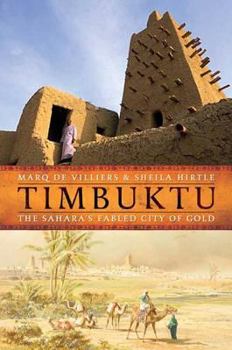Timbuktu: The Sahara's Fabled City of Gold
Select Format
Select Condition 
Book Overview
Timbuktu the name still evokes an exotic, faraway place even though its glory days are long gone. Unspooling its history and legends, resolving myth with reality, Marq de Villiers and Sheila Hirtle... This description may be from another edition of this product.
Format:Hardcover
Language:English
ISBN:0802714978
ISBN13:9780802714978
Release Date:August 2007
Publisher:Walker & Company
Length:302 Pages
Weight:1.35 lbs.
Dimensions:1.1" x 6.5" x 9.5"
Customer Reviews
1 rating
Great overview of a fascinating and mythical city
Published by Thriftbooks.com User , 16 years ago
_Timbuktu_ by Marq De Villiers and Sheila Hirtle is an engaging history of that fabled Saharan city, its name once synonymous in the West with both remoteness and as a place of wealth beyond imagination, of golden spires and wise and tremendously rich kings, exerting a "hypnotic attraction on the Mediterranean world." It was similarly revered in the east as a major urban center in the Islamic world, for centuries a nexus of caravan trade in Saharan salt, gold from Ghana, and slaves as well as a center of learning and scholarship. Surprisingly (at least for Western travelers past and present) for all its great fame Timbuktu has always been a city made largely of mud and unpaved streets of sand. Not a city made of gold, reflecting its local earthly origins, the city is "all beiges and dun, shading into the desert and scarcely distinguishable from it." Though there are a few mosques and houses made of brick and some stone, most buildings are mainly made of dried mud (pisé or pounded clay, which the locals call banco). Even the newer parts of town, laid out in a grid, are made of mud brick. Sadly, a shrinking population in the city has no money or manpower to repair an entire city of mud, one that melts in the wet-season rains unless protected by fresh plaster. By the way the spines that appear on Timbuktu buildings "like porcupine quills" are actually stone beams which serve as in-place scaffolds to help repair buildings when the rains come. Timbuktu is even today a multi-ethnic city, reflecting its cosmopolitan past. The authors provide a quick profile of many of the ethnic groups that make up the city, including the Tuareg ("the most recalcitrant and farthest-traveled of the Berbers"), the Mande people (the dominant black African people along the Niger, governed two of the most powerful ancient African empires, and are the dominant ethnic group in Mali today), the Fulani (their origins reflecting a mixture of incoming Berbers and native Wolof), as well as the Dogon and the Songhai. I found the information provided on the landscape and surrounding region of Timbuktu - particularly prior to its foundation and in its earlier years - quite fascinating. The Niger River used to flow much closer to the city and with greater volume. Hippos once wallowed near the city. Even more astonishing, a sizable forest once grew near Timbuktu, with many travelers and residents reporting elephants. That forest is now long gone, to some degree caused by direct human activity - Sonni Ali, a ruler of Gao, hewn down entire forests to construct boats to strike at his upriver enemies - but quite possibly the forest was doomed in any event due to gradual human attrition and increasing desiccation. Sadly, though elephants appear to have been gone from the area for centuries, others, such as giraffes and lions, vanished as recently as the 20th century. All too briefly the authors touch on the recent discoveries of settlements, including dozens of large cities, t




